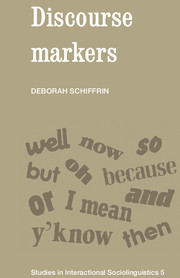Book contents
- Frontmatter
- Contents
- Acknowledgements
- Intonation and transcription conventions
- 1 Background: What is discourse?
- 2 Prelude to analysis: Definitions and data
- 3 Questions: Why analyze discourse markers?
- 4 Oh: Marker of information management
- 5 Well: Marker of response
- 6 Discourse connectives: and, but, or
- 7 So and because: Markers of cause and result
- 8 Temporal adverbs: now and then
- 9 Information and participation: y'know and I mean
- 10 Discourse markers: Contextual coordinates of talk
- Notes
- References
- Author index
- Subject index
6 - Discourse connectives: and, but, or
Published online by Cambridge University Press: 05 June 2012
- Frontmatter
- Contents
- Acknowledgements
- Intonation and transcription conventions
- 1 Background: What is discourse?
- 2 Prelude to analysis: Definitions and data
- 3 Questions: Why analyze discourse markers?
- 4 Oh: Marker of information management
- 5 Well: Marker of response
- 6 Discourse connectives: and, but, or
- 7 So and because: Markers of cause and result
- 8 Temporal adverbs: now and then
- 9 Information and participation: y'know and I mean
- 10 Discourse markers: Contextual coordinates of talk
- Notes
- References
- Author index
- Subject index
Summary
In my discussion so far, I have focused on expressions (oh, well) whose linguistic contribution to their discourse function as markers is minimal. I now shift to a very different set of markers: and, but, and or. Because these elements have a role in the grammatical system of English, their analysis as markers has to proceed somewhat differently: in addition to characterizing the discourse slot(s) in which they occur, we need to consider the possibility that grammatical properties of the items themselves contribute to their discourse function. Thus, after my description of their discourse function, I will consider possible relationships between these functions and the syntactic, semantic, and pragmatic properties of conjunctions. We will also see that these markers form a set of discourse connectives, and that they have both ideational and pragmatic functions in talk (i.e. in exchange and action structures, and in participation frameworks).
And
And has two roles in talk: it coordinates idea units and it continues a speaker's action. Although and has these roles simultaneously, it will be easier to demonstrate them by describing them separately.
Building a text
I begin by observing that and is the most frequently used mode of connection at a local level of idea structure: 1002 clause-sized idea units in my corpus were prefaced by and, compared to 440 by but, 206 by so, and only 53 by or.
Information
- Type
- Chapter
- Information
- Discourse Markers , pp. 128 - 190Publisher: Cambridge University PressPrint publication year: 1987
